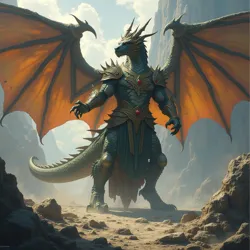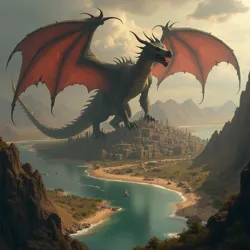Dragon King

Vast dominion and near-absolute authority of the Dragon Kings before the Chronospoorium era, shaping landscapes and wielding immense power.
Apex rulers, vast dominion
Palpable decline, fragmented
Draconic might, inherent capabilities
23
City destroyed, history erased
Rumored decline (~22 years ago)
True
| Event | Approximate Time (Years Ago) | Dragon King Involvement | Outcome/Impact |
|---|---|---|---|
| Gelphar Eradication | 23 | Direct action by a Dragon King | City destroyed, history erased, witnesses silenced; leads to founding of Gelp |
| Pursuit of Genies | ~22-23 | Dispatch of a fey bounty hunter acting on Dragon King's behalf | Bounty hunter slain, Jenny the Genie freed; group defies Dragon King authority |
| Rumors of Decline | ~22 | Implied state of the draconic species supporting the Kings | Contributes to political instability, waning confidence in imperial power |
| Silver Liquid Dragon Creature Appearance | ~22 | Unknown (potential link or new threat) | Encountered at Seafort and start cave; perceived threat by clones and group |
The Dragon King refers to the historically dominant power, or collective thereof, whose vast dominion once encompassed significant swathes of the known lands. Prior to the upheavals chronicled in the Chronospoorium of the Bleeding Mold, the authority of the Dragon Kings was near-absolute, their influence shaping the political, social, and even geographical landscape of numerous regions. Their power derived from both immense inherent capabilities, often associated with draconic might, and sophisticated, albeit often ruthless, methods of governance and control. Historical accounts from before the current era of instability frequently depict the Dragon Kings as apex rulers, capable of feats of destruction and manipulation on a scale unmatched by other powers, including the nascent Drossian Empire in its earlier centuries.
The era of the Chronospoorium, however, marks a palpable decline in the overt power and visibility of the Dragon Kings. While still capable of isolated acts of immense power, such as the devastating Gelphar Eradication, their collective grip appears weakened, their influence fragmented, and their presence increasingly shrouded in mystery. Whispers of internal strife, waning draconic vitality, and the rise of new, unpredictable threats plague their former territories, contributing significantly to the widespread instability characteristic of this turbulent period. The Dragon Kings, once the anchors of the world's power structure, now seem to be grappling with their own existential challenges, their actions during this time often appearing reactive or desperate rather than the calculated assertions of supreme authority seen in earlier ages.
Historical Dominance and Gradual Decline
For centuries preceding the events of the Chronospoorium of the Bleeding Mold, the Dragon Kings held sway over an immense territory that stretched from the northern reaches of Frigir to the southern coasts bordering the Loroth Sea. Their empire, though not always unified under a single banner, represented a formidable network of power centers, each ruled by a figure or council claiming the mantle of Dragon King. This system of governance often involved a complex hierarchy of lesser dragonkin, human vassals, and subjugated peoples, bound together by oaths, tribute, and the ever-present threat of overwhelming draconic force. The legacy of their rule is evident in the architecture, infrastructure, and even the geological features of the lands they controlled, many of which bear the scorch marks or seismic shifts indicative of draconic presence. Ancient texts and oral traditions speak of periods of relative peace enforced by draconic law, interspersed with brutal campaigns of conquest and suppression against those who dared defy their authority.
 Fragmentation of the Dragon King empire over centuries due to territory scale, rising powers like the Drossian Empire, and internal conflicts.
Fragmentation of the Dragon King empire over centuries due to territory scale, rising powers like the Drossian Empire, and internal conflicts.The decline of this extensive dominion was not a sudden collapse but a protracted process, unfolding over decades. Several factors are believed to have contributed to this erosion of power. The sheer scale of the territory proved difficult to govern effectively, leading to regional governors or client states gaining increasing autonomy. The rise of other significant powers, such as the Drossian Empire, provided alternative centers of influence and potential resistance. Furthermore, internal conflicts among the Dragon Kings themselves, possibly stemming from disputes over territory, resources, or succession, are whispered to have weakened their collective strength. These internal divisions, combined with external pressures, created fissures in the foundation of their empire, making it vulnerable to the new threats that would emerge during the Chronospoorium.
Compounding these political and military challenges was a more fundamental issue: the apparent decline in the draconic population itself. Rumors circulating during the height of the Chronospoorium, particularly noted around the time of the Battle of South Palrose, suggested that the dragons were "dying off." While the precise nature and cause of this phenomenon remain unclear – whether it refers to a biological decline, a magical affliction, or a withdrawal from the world – it directly impacts the source of the Dragon Kings' power and legitimacy. The absence of powerful dragons, or the perception of their weakening, would inevitably diminish the authority of those who claimed dominion through them, further accelerating the fragmentation of their former empire and contributing to the power vacuum that defines the current era.
Actions During the Chronospoorium
Despite their apparent decline, the Dragon Kings remained capable of wielding immense power and influence during the Chronospoorium of the Bleeding Mold. Their actions, though perhaps less coordinated than in previous eras, were often decisive and devastating, shaping key events of the period. One of the most significant and chilling examples is the Gelphar Eradication, which occurred approximately twenty-three years before the main narrative focus. This was not a conventional military campaign but a deliberate act of historical erasure.
 Isolated but devastating actions during the era of instability, including the Gelphar Eradication and dispatching agents like the fey bounty hunter.
Isolated but devastating actions during the era of instability, including the Gelphar Eradication and dispatching agents like the fey bounty hunter.A Dragon King, identified as the perpetrator, utterly destroyed the city of Gelphar. The destruction was so complete that Gelphar effectively vanished from maps and historical records. The act was accompanied by a systematic effort to silence all witnesses to the city's existence and hunt down any remaining Genasi navy ships that might have survived the catastrophe. This level of targeted, total obliteration suggests a motive far deeper than simple conquest, perhaps aimed at removing a specific threat, burying a secret, or preventing knowledge of certain events from spreading. The subsequent emergence of Gelp on the same site, a seemingly unremarkable fishing town heavily supported by the Drossian Empire, adds another layer of intrigue, implying a deliberate cover-up or manipulation of the region's history, possibly orchestrated or facilitated by the Dragon King responsible or their agents.
The Dragon Kings also continued to assert their authority through various agents. During the events at Dross Southern Seafort, a fey bounty hunter is encountered who claims to be acting on behalf of the Dragon King. His mission is to capture 'wild' genies, presenting this task as necessary for the protection of the people of 'Dragon-Frey' from unspecified perils. This suggests that the Dragon Kings maintained territories or protectorates, such as Dragon-Frey, and continued to enforce their own forms of law or control within them. The bounty hunter's pursuit of genies, particularly 'wild' ones, implies a potential connection between the Dragon Kings and these powerful elemental beings, perhaps viewing them as resources to be controlled or threats to be neutralized if not bound to their service. The group's decision to defy this agent and protect Jenny the Genie marks a direct confrontation with the Dragon King's authority, albeit through a proxy.
Furthermore, the pervasive rumors during the Chronospoorium about the dragons themselves dying off directly impact the perception and reality of the Dragon Kings' power. While not an action initiated by the Dragon Kings, this biological or existential crisis within the draconic species inevitably weakens the foundation of their rule. It explains, in part, the fragmentation of their territories and the growing boldness of other factions. The Dragon Kings' actions during this period, such as the Gelphar Eradication or the dispatch of agents like the bounty hunter, might be interpreted as desperate attempts to maintain control, eliminate threats, or secure vital resources in the face of their own impending decline.
Political Structure and Influence
The political structure associated with the Dragon Kings throughout history has varied, though it generally centers on the absolute authority of the Dragon King figure or figures. In their periods of greatest power, this likely manifested as a feudal or imperial system, with the Dragon King at the apex, commanding the loyalty of lesser dragonkin, dragonborn, and powerful mortal vassals. These vassals would govern specific territories, collect tribute, and raise armies in the Dragon King's name. The Dragon Guard, mentioned in relation to the Dross Southern Seafort during the Defense of Dross Southern Seafort, may represent a lingering institution or legacy of this older Dragon King political order, possibly a military force once sworn directly to the Dragon Kings before being integrated into or supplanted by the Drossian Empire.
The relationship between the Dragon Kings and other major powers, particularly the Drossian Empire, is complex and appears to have shifted significantly over time. Historically, the Dragon Kings likely held a dominant position over the region that would become the Drossian Empire. The empire's rise may have occurred as the Dragon Kings' power waned, allowing Dross to expand its influence and consolidate control over former Dragon King territories or vassal states like Palrose. Despite this shift in the balance of power, the Dragon Kings retained the capacity for unilateral, devastating actions, as demonstrated by the Gelphar Eradication, which directly impacted a region later associated with Drossian influence (Gelp). The Drossian Empire's support for the new settlement of Gelp might even be seen as an attempt to assert control or bury the evidence of the Dragon King's destructive act.
The Dragon Kings also exerted influence over specific groups, such as the Genasi, as evidenced by the hunting of their ships after the Gelphar destruction and the pursuit of 'wild' genies by the fey bounty hunter. This suggests a history of conflict, subjugation, or perhaps even attempted assimilation of Genasi populations into the Dragon King's domain. Their use of agents like the fey bounty hunter highlights their continued ability to project power and enforce their will, even in regions no longer under their direct control. The specific targeting of 'wild' genies implies a distinction between genies under Dragon King control or patronage and those who remain independent, viewing the latter as a threat or resource to be exploited.
Within the context of the Chronospoorium, the Dragon Kings' political influence is characterized by its fragmented nature. Rather than a unified front, there appear to be individual Dragon Kings or factions operating with their own agendas. The absence of a central, visible Dragon King figure further contributes to the political instability of the era. The vacuum left by their declining central authority allows other forces, including the Cloning Phenomenon, Temporal Entities, and regional powers like the Drossian Empire, to maneuver and compete for dominance, plunging the world into the chaos described in the source text.
Nature of the Dragon Kings
The precise nature of the entity or entities referred to as the "Dragon King" remains subject to interpretation and historical debate. The source text sometimes uses the singular "Dragon King" (e.g., responsible for the Gelphar Eradication, dispatching the fey bounty hunter) and at other times the plural "Dragon Kings" (referring to their former vast territories and weakening grip). This ambiguity raises questions: Is "Dragon King" a title held by a single, immensely powerful being, a lineage of such beings, a council of the most ancient and powerful dragons, or perhaps even a collective consciousness or entity representing the apex of draconic power?
 Speculation on whether the Dragon King is a single being, a council, or a lineage, tied to the vitality of the draconic species and possibly manifesting in new forms like the Silver Liquid Dragon Creature.
Speculation on whether the Dragon King is a single being, a council, or a lineage, tied to the vitality of the draconic species and possibly manifesting in new forms like the Silver Liquid Dragon Creature.The most common understanding posits that the Dragon Kings are exceptionally powerful, possibly ancient, individual dragons who hold or have historically held dominion over significant territories. Their power is inherently tied to their draconic nature, allowing them feats of immense physical destruction, magical manipulation, and possibly even influence over the fabric of reality, as hinted by the erasure of Gelphar from history. The rumors of "dragons themselves dying off" suggest that the Dragon Kings are intrinsically linked to the health and vitality of the wider draconic species. If the species is in decline, it stands to reason that the power of the Dragon Kings, who represent its pinnacle, would also be diminished.
Some historical theories propose a connection between the Dragon Kings and the very land they rule. Certain ancient texts, particularly those found in the Ashfall Peaks, a volcanic mountain range historically associated with draconic lairs, suggest that the Dragon Kings' vitality was linked to the geological stability and magical energy of their core territories. A decline in one could mirror a decline in the other, potentially explaining both the rumors of dying dragons and the widespread environmental instability, including the spread of the Fungus Plague, during the Chronospoorium. This theory, however, remains largely speculative and lacks widespread acceptance among modern scholars.
The encounter with the strange, Silver Liquid Dragon Creature at Dross Southern Seafort and later in the start cave adds another layer of mystery regarding the nature of draconic power and its potential manifestations. Is this entity a new, mutated form of draconic life, a byproduct of the temporal anomalies and biological threats plaguing the era, or perhaps something entirely different yet connected to the decline or transformation of the Dragon Kings? The fact that this 'silver goo' is perceived as a threat by the 'clone' conspirators suggests it is an independent, hostile force, possibly linked to the temporal instability or the underlying causes of the Chronospoorium itself. Its connection to the Dragon Kings, if any, remains unknown, but its draconic descriptor invites speculation about the changing forms and threats emerging from the remnants of draconic power.
Table of Key Dragon King Actions (Chronospoorium Period)
Decline and Future Uncertainty
The decline of the Dragon Kings, a process underway long before the Chronospoorium of the Bleeding Mold, has accelerated dramatically during this period of widespread instability. The fragmentation of their former empire is now a stark reality, with regions like Palrose and Frigir navigating their own crises, often with little or no apparent intervention from their former overlords. The Drossian Empire, while facing its own collapse due to the Fungus Plague and internal strife, has effectively supplanted the Dragon Kings as the dominant mortal power, even if its hold is tenuous.
The persistent rumors of dragons dying off, coupled with the increasingly erratic and isolated nature of the Dragon Kings' actions (such as the seemingly targeted yet ultimately localized Gelphar Eradication), paint a picture of a power structure in its twilight. The once-feared rulers now appear to be struggling for their own survival, perhaps diverting their remaining resources and energy towards combating whatever existential threat is afflicting the draconic species or dealing with the emergence of unpredictable phenomena like the Temporal Entities or the 'silver goo'.
The future of the Dragon Kings is uncertain. Will they adapt to the new reality of the Chronospoorium, finding new ways to assert their influence amidst the chaos? Will the decline of the dragons be terminal, leading to the eventual extinction of the Dragon Kings as a power? Or will they undergo a transformation, perhaps giving rise to new forms of draconic entities or powers, such as the enigmatic Silver Liquid Dragon Creature? The answers to these questions remain unknown, lost in the temporal distortions and pervasive threats that define the current era. Their legacy, however, continues to shape the world, a reminder of a time when scaled monarchs reigned supreme, their power a force of nature that could both build empires and erase cities from existence. The ruins scattered across the landscape, from the scorched peaks of the Ashfall Peaks to the secret buried beneath Gelp, serve as silent testaments to their former glory and the profound impact of their actions, even in their decline.
The Dragon Kings, once undisputed masters, now exist as a fading power, their fate intertwined with the unfolding disasters of the Chronospoorium. Their involvement in the events of this era, from the destruction of Gelphar to the dispatch of agents and the backdrop of their own species' struggle, highlights their continued, albeit diminished, relevance in a world increasingly defined by new threats and the struggle for survival.